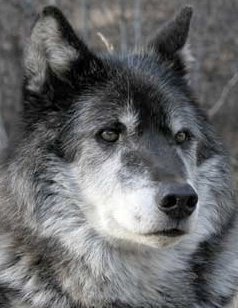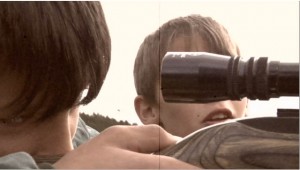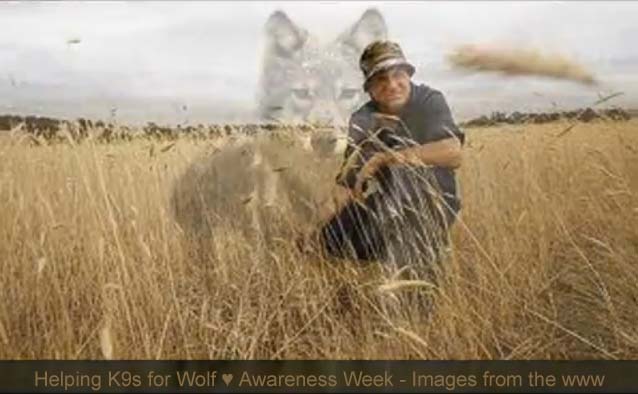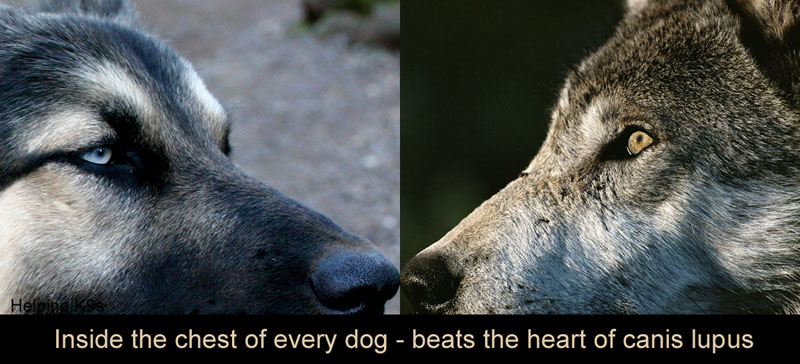Page and information links for the life of “Koani” assembled here for all of you who love canines, domestic or wild, and want their lives with us humans to be one of responsible, joyous coexistence.
The beautiful story “The Gift” below is taken from the Wild Sentry Newsletter #53 Spring/Summer 2007, the one titled: Koani’s Last Days. Link to the website: wildsentry.org

I am touched by the story and live of this wolf, Koani, ambassador to her species, and the way Pat Tucker and Bruce Weide changed their lives to do her justice, if such a thing was possible, to give her life meaning, her, who could never be free, and allowed themselves to be transformed in the process. Years after Koani’s death, it looks as if a movie about her live will finally be finished. Anyone loving canines and wolves, this is a story to investigate.
I am sharing the story – The Gift, by Bruce Weide – because I think it makes a case for education. I say this in light of the issues facing all canines sharing this planet with us. You never know the effect something seen or heard will have on a young person’s live – and working in schools and with children must become commonplace for the sake of compassionate respectful and responsibly managed coexistence for canines and men.
The Gift
by Bruce Weide
I grew up knowing wolves were bad, it was part of my
family folklore, I’d seen it in movies, read it in books, and
confidently reported that “Wolves eat people” in a 4th
grade science assignment. Something changed my mind
and it happened only days before I held the life of a wolf
in the crosshairs. Before I read Leopold’s Thinking Like a
Mountain, or Lopez’s Of Wolves and Men, or Mowat’s Never
Cry Wolf, I saw a documentary, Death of a Legend. This
would’ve been 1968 and the program was ahead of its
time. I was 15 and, like Leopold, full of trigger itch. This
essay first appeared in Wild Sentry #38, Dec. 2002. I
wanted to reprint it because, as I see it, this was the first
step that led to my involvement with wolves and my time
with Koani. In addition, this is my testimonial to the
transformative power of education.
MY FINGER TIGHTENED AGAINST THE TRIGGER, and with a
bit more pressure, less than that exerted by the breath
of a hummingbird, it would’ve been a shot clean
through her heart.
I lived in Alaska shortly after the earthquake and prior to
the pipeline, in 1966. My best friend, Derek, and I knew we
could make our bloody fortunes killing wolves. The way we
saw it, we would perform a service for our country and get
rich on the $50 bounty paid for each dead wolf. I was thirteen
at the time and didn’t pay attention to wolf politics. Wolf politics didn’t exist at the time. Most people knew that wolves were bad and should be killed.
True, Adolph Murie had published his seminal monograph,
The Wolves of Mount McKinley in 1944—but, except for other
wildlife biologists, not many people read wildlife research studies. Farley Mowat’s Never Cry Wolf, published in 1963, told a new story and provided a catalyst that would help change people’s attitudes towards the wolf. But I, and many others, had yet to read the book. Most people still didn’t question the evil of wolves.
One’s point-of-view is acquired from stories that provide
the foundation for how one interprets reality. Mythologist Joseph Campbell captured the essential importance of stories when he pointed out that myths, and therefore stories, are the protective nest that humans instinctively build to protect our young. We can’t help but tell stories and from them we learn the values with which we perceive the world around us. Here’s a personal example from my family folklore.
The story tells how Grandpa escaped being eaten by a wolf.
As the story goes, one day my Grandpa, who as a boy lived on the open plains of Nebraska, was kept after school. (For being naughty? No one ever brought that up, but being
devoured by a wolf is a penalty for fairytale disobedience.) In those days, of course, everyone walked many miles to school, be it through rain, sleet, or snow. As Grandpa started his long trek home in the fading light, he noticed a wolf following him. The wolf pursued him the entire way. Only through the grace of God did Grandpa make it to the back porch door—the wolf hot on his heels with only one intention: to make Grandpa its next meal. Or so the story was told. No one ever thought about the fact that a wolf, able to run forty miles-per-hour, could’ve slaughtered Grandpa anywhere along the route home—had it truly wanted to dine on him. From what I know now, but never would’ve stopped to consider 45 years ago, is that the wolf’s behavior exhibited more curiosity than hunger.
In the fourth grade, I wrote a report about wolves in which I listed the main items in a wolf’s diet: elk, deer, cattle, sheep, and people. I possessed a firm belief that wolves presented a clear and present danger to humans.
In the fall of 1966, Derek and I and our fathers boarded the
train out of Anchorage and rode the rails north to hunt moose.
The train stopped to let people off anywhere along the route.
When you wanted to go home, you stood by the track, the train
stopped, and you climbed aboard. We disembarked at Honolulu,
an abandoned train station. We set up camp and hunted.
Late in the afternoon of the third day, as Derek and I
searched for moose, I noticed a wolf on a low ridge top, a
hundred to two hundred yards away. Actually, I don’t remember
how close the wolf was to us—this happened 36 years ago and
elements of the hunting trip have gone fuzzy or been forgotten
entirely. But the broad strokes of the story, the important details,I recall as if this pivotal event in my life occurred yesterday.
The air held the light and clarity of a brisk autumn
afternoon. I saw the wolf but said nothing to Derek. The wolf
remained on the ridge as it followed and watched us. After five minutes—maybe it was less, maybe it was more—I motioned
Derek to stop, put a finger to my lips, and pointed.
Derek’s eyes grew large and he nodded enthusiastically.
“He’s yours,” Derek whispered.
I raised the 30.06 to my shoulder. The rifle stock felt cool
against my cheek as I sighted-in through the scope. The wolf stood, its legs close together and its narrow chest fully exposed. In the chilled air the wolf’s breath floated like thin fog in the yellow light of afternoon. I set the cross hairs over the wolf’s heart. A slight breeze stirred the tawny gray fur around the wolf’s neck. I slowly exhaled and released the safety, holding a finger over the mechanism
to muffle the sound. The wolf must’ve heard the dull click because its ears perked up and its head cocked to the side. I formed my finger around the cold metal of the trigger and began to squeeze.
Through the scope, the wolf’s amber-green eyes stared at me. But the wolf’s eyes did more—and I know this will sound farfetched, especially coming from the memory of a boy only thirteen with little appreciation for wolves.
I felt as if the wolf’s eyes peered into my soul and then on
through me. I felt exposed and naked before a primal and enduring force, as if I were an inconsequential ghost that only partially obscured what really mattered.
“Take him, he’s yours,” Derek whispered, his voice tense
and urgent. “Shoot!”
The wolf stared into me. The eyes reflected intelligence
and a maturity that, at the time, I couldn’t come close to
comprehending. Much later, I would understand that the eyes,
honed by millions of years, were those of a supreme predator.
I questioned what I was about to do. My finger around
the trigger relaxed. And then tightened. And relaxed.
Why?
On a Sunday afternoon, a couple weeks earlier, I’d
watched Death of a Legend, a documentary that told a new
story about wolves and didn’t portray the animal as evil. The
program examined the wolf’s natural history and explained how
stories, fairy tales, folklore, and legends influenced our perception of the animal. But a particular scene from the documentary replayed itself in my mind’s eye that autumn afternoon as I stood with rifle poised and cross hairs targeted on the wolf’s heart.
In black and white footage, a dark wolf runs across the
snow. A group of men line up like a firing squad and open fire. Patches of snow explode around the wolf. A bullet slams into the animal and she falls. The rifles continue to fire. The wolf struggles to stand as another bullet hits her and another and another. The wolf slumps to the snow. The men continue firing. The wolf doesn’t move except when bullets cause the body to jerk in epileptic spasms. Tufts of fur burst into the air. Finally the rifles cease. The men run to the wolf. One of the men lifts the wolf ’s head for the camera. The wolf’s tongue hangs from her mouth and her eyes glaze as the men smile and congratulate each other.
I peered through the tunnel of a riflescope into the eyes of the wolf, seeing neither malevolence nor good. I saw ancient memory so deep that, like a well, the bottom remained obscured by mystery.

I slid my finger from the trigger and lowered the rifle. “What’re you doing?” Derek hissed.
“Nothing,” I said. “You just threw away fifty dollars,” Derek hissed in a tone that clearly implied I must be crazy.
Derek raised his rifle. I held out my hand to stop him.
“He’s mine,” I said.
Thirteen-year-old males aren’t the best at articulating their
feelings. Years would pass before I found words to describe
what I felt when the wolf looked into my soul. In fact, for
many years I never spoke of the incident because, on one level, I felt foolish. But on that autumn afternoon, as the heat of the wolf’s eyes burned into my memory, I felt, as irrational as it seemed, that I’d done the only thing I could do.
Please don’t make the mistake of viewing me as someone
who thought he’d done the right thing. At the moment, I felt
guilty of committing a grave wrong. As an adolescent boy I
strived hard to display manliness and I felt as if… no, I knew
I’d compromised my manhood. Nevertheless, something led
me to the enigmatic knowledge that inaction was the only action I could take. In some unspoken manner, I must’ve communicated this to Derek. And good friend that Derek was, he didn’t question me any further.
There’s no denying that looking into the eyes of a wolf
affected me. But the real question remains, without having seen the documentary, would gazing into the wolf’s eyes have stopped my finger? So many years later, it’s a point open to debate. I believe that environmental education in the form of a wildlife documentary presented me with a gift in the form of a new story that allowed the wolf’s eyes to speak to me. I do know that the eyes of the wolf acted like a mirror that reflected my soul. Right or wrong, I didn’t want to see myself as one of those men in the firing squad. That was not the role I wished to play in the story of my life.
Click here for a summery article about how it all came about
Excellent excellent info for anyone considering owning a wolf hybrid
Video: There is a Wolf in the Classroom (original trailer ?)
Video: True Wolf – Trailer
TRUE WOLF OFFICIAL TRAILER from Rob Whitehair on Vimeo.

